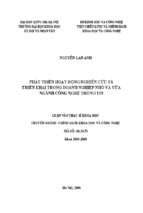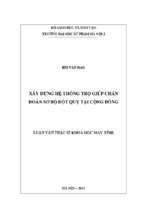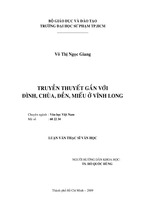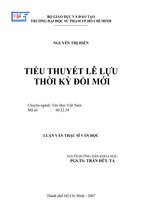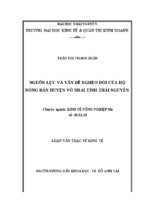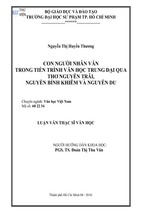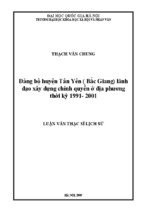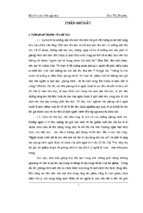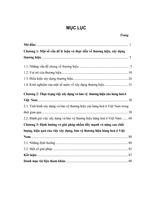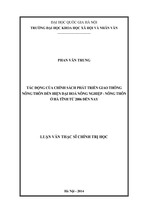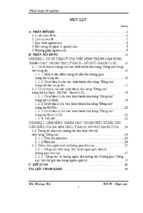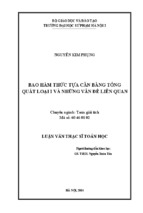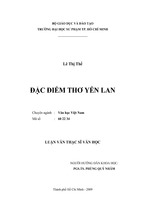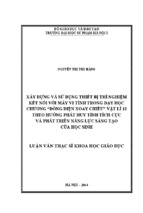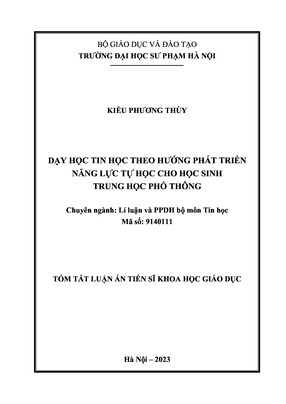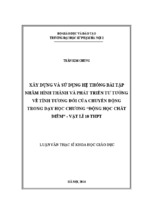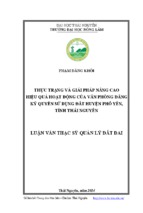Political communication plays an important role in both verbal and nonverbal communication. In addition to verbal code, nonverbal code plays an important role as a transparent explanation of political communication. Choosing a specific context to analyze the nonverbal communication, the researcher provides the reader a general knowledge of nonverbal communication and American politicians‘ gestures in disagreement showing in particular. From this, enormous impacts of low context culture on the disagreement expression of American politicians have been manifested. More specifically, the study began with the literature review on the terms related to the topics. Then by using descriptive and qualitative methods in data analysis, the researcher can find out the answers for two research questions. Also, the suggestions for further research will be drawn out. This study hopefully makes a certain contribution to a world of knowledge and numerous researches with the relevant topic.
VIETNAM NATIONAL UNIVERSITY, HANOI
UNIVERSITY OF LANGUAGES AND INTERNATIONAL STUDIES
FACULTY OF ENGLISH LANGUAGE TEACHER EDUCATION
GRADUATION PAPER
A STUDY OF AMERICAN POLITICIANS’
GESTURES IN DISAGREEMENT SHOWING IN THE
UNITED STATES HOUSE MEETINGS
Supervisor: Ngô Hữu Hoàng
Student: Hoàng Thị Thu Trang
Course: QH2010.F1.E19
HÀ NỘI - 2014
ĐẠI HỌC QUỐC GIA HÀ NỘI
TRƯỜNG ĐẠI HỌC NGOẠI NGỮ
KHOA SƯ PHẠM TIẾNG ANH
KHÓA LUẬN TỐT NGHIỆP
MỘT NGHIÊN CỨU VỀ NHỮNG CỬ CHỈ BÀY TỎ
SỰ KHÔNG ĐỒNG TÌNH CỦA CÁC NHÀ CHÍNH
TRỊ NGƯỜI MỸ TẠI CÁC KÌ HỌP QUỐC HỘI
Giáo viên hướng dẫn: Ngô Hữu Hoàng
Sinh viên: Hoàng Thị Thu Trang
Khóa: QH2010.F1.E19
HÀ NỘI - 2014
ACCEPTANCE
I hereby state that I: HOÀNG THỊ THU TRANG, 10E19, being a candidate
for the degree of Bachelor of Arts (TEFL) accept the requirements of the College
relating to the retention and use of Bachelor’s Graduation Paper deposited in the
library.
In terms of these conditions, I agree that the origin of my paper deposited
in the library should be accessible for the purposes of study and research, in
accordance with the normal conditions established by the librarian for the care,
loan or reproduction of the paper.
Signature
Hoàng Thị Thu Trang
Date: 25/4/2014
i
ACKNOWLEDGEMENTS
This paper would not have been completed without the support of many
people, to all of whom I am profoundly grateful. First of all, I would like to express
my deepest gratitude to my supervisor, Dr. Ngô Hữu Hoàng for his invaluable
guidance, and perceptive comments as well as the strong motivation he generated. I
can‘t express how grateful I am for my parents‘ support. They always stand by me,
encourage me to overcome all challenges and become my endless inspiration.
My sincere thanks also to my teachers and my classmates for sharing their
knowledge, experience which help me more in the process of conducting this thesis.
I am also thankful to my beloved friends: Mai, Nhung, Hồng and my roommates,
classmates in the University of Languages and International Studies for their
constant supportiveness and encouragement when I encountered difficulties in
completing the study.
Last but not least, I would like to thank the readers who share their
concerning and feedback on this study. Thanks all for creating the most favorable
conditions for me to fulfill this research.
ii
ABSTRACT
Political communication plays an important role in both verbal and
nonverbal communication. In addition to verbal code, nonverbal code plays an
important role as a transparent explanation of political communication. Choosing a
specific context to analyze the nonverbal communication, the researcher provides
the reader a general knowledge of nonverbal communication and American
politicians‘ gestures in disagreement showing in particular. From this, enormous
impacts of low context culture on the disagreement expression of American
politicians have been manifested. More specifically, the study began with the
literature review on the terms related to the topics. Then by using descriptive and
qualitative methods in data analysis, the researcher can find out the answers for two
research questions. Also, the suggestions for further research will be drawn out.
This study hopefully makes a certain contribution to a world of knowledge
and numerous researches with the relevant topic.
iii
TABLE OF CONTENTS
ACCEPTANCE
i
ACKNOWLEDGEMENTS
ii
ABSTRACT
iii
TABLE OF CONTENTS
vi
LIST OF TABLES
vii
LIST OF ABBREVIATIONS
viii
PART I: INTRODUCTION
1
1. Rationale of the study
1
2. Objectives of the study
2
3. Research questions
2
4. Scope of the study
2
5. Significance of the study
3
6. Method of the study
4
7. Organization of the study
4
PART II: DEVELOPMENT
5
CHAPTER I: LITERATURE REVIEW
5
1.1 Nonverbal communication
5
1.1.1 Definition
5
1.1.2 The importance of nonverbal communication
6
1.1.3 Political aspect of nonverbal communication
7
1.1.4 Emotional influences in nonverbal communication
8
1.2 Cultural context
8
1.2.1 High context culture
9
iv
1.2.2 Low context culture
10
1.2.3 American culture and low context culture
11
1.2.4 The United State House Meetings
11
1.3 Gesture
11
1.3.1 Definition
11
1.3.2 Gesture classification
13
1.3.3 Significance of gesture in conversations
17
1. 4 Disagreement and disagreement gestures
17
1.4.1 Definition
17
1.4.2 Level of disagreement
18
1.4.3 Gestures conveying the disagreement
18
i) Palm gestures
19
ii) Finger gestures
19
iii) Hand gestures
20
iv) Arm gesture
22
CHAPTER II: METHODOLOGY
25
2.1 Contextual variables
24
2.2 Research instruments
24
2.3 Procedures of data collection
25
2.4 Procedures of data analysis
25
CHAPTER III: FINDINGS AND DISCUSSION
27
3.1 The study for research question 1
28
3.1.1 Video analysis
28
3.1.2 Statistic synthesis
36
3.2 The study for research question 2
37
3.2.1 Communication consequences of low-context cultural orientations
37
3.2.2 Low context culture affects the disagreement showing of the American 37
v
politicians
PART III: CONCLUSION
40
1. Summary of the findings and concluding remarks
40
2. Implication of the study
40
3. Limitations of the study
41
4. Suggestions for further studies
41
REFERENCES
42
vi
LIST OF TABLES
Table 1
Structure of Congress
10
Table 2
Encoding disagreement gestures
26
Table 3
The frequency of occurrence of disagreement gestures in videos 35
Table 4
The classification of gestures based on level of disagreement
vii
36
LIST OF ABBREVIATIONS
The U.S: The United State
NVC: Nonverbal Communication
LC: Low context
viii
PART I: INTRODUCTION
This initial part states the rationale for the study, together with objectives,
scope, significance and method of the study. Also, an overview of the rest of the
paper is provided to orientate the readers throughout the study.
1. Rationale of the study.
In 2013, the master of body language– Allan Pease, paid a visit to Vietnam
and had a very interesting talk to the Vietnamese audience in the ―Talk Vietnam
Show‖- one of the most well-known shows on VTV4. He shared with Vietnamese
participants so many fascinating facts about the nonverbal communication which
made a deep impression on me at that time. He said that body language was the
best way to understand a person and from which we would have the best manner.
After watching such a wonderful show on VTV4, it came to my mind that I would
make research on this field if I had any chance. Besides, realizing the application of
Nonverbal Communication, especially the importance of gestures in political fields,
I had a strong determination to do a small research involving in this topic.
The second reason is that to know another‘s language and not his culture is a
very good way to make a fluent fool of one‘s else. English has become an
international means of communication in our modern life. It is undeniable that its
contributions to science, technology, economy, culture, especially politics are
significant. In Vietnam, the number of people learning English has increased
substantially. Most of them just have spent a lot of time and effort with an view to
mastering the grammar, vocabulary as well as the sentences but not concerning to
the cultural background. This leads to unexpected consequences such as culture
shocks or cultural behavior makings. Hence, enriching the knowledge of cultures in
general and the knowledge of nonverbal communication in particular will help you
to behave appropriately.
1
Finally, the disagreement showing in verbal cues has been studied by some
researches but in nonverbal behavior is not concerned much.
All of these above wonderings give me the inspiration to conduct this small
research with the hope to provide essential and fascinating information about
disagreement gestures of American politicians in the U.S House Meetings.
2. Objectives of the study.
The study was conducted with the following objectives:
-
Pointing out the importance of nonverbal communication in political
communication.
-
Ascertaining that American politicians use various gestures to show
disagreement in the U.S House Meetings.
-
Finding out the main gestures being used by American politicians to show
the disagreement in the U.S House Meetings.
-
Finding out how low context culture affects the way American politicians
showing their disagreement.
3. Research questions
Putting this theme in a specific context- the U.S House meetings, the researcher
is on the road to find the answers for the two following questions:
(1) What are disagreement gestures utilized by American politicians in The
United States House meetings?
(2) How does the cultural context affect the disagreement showing of
American politicians?
4. Scope of the study
Admittedly, nonverbal communication is an interesting broad subject for
researchers to discover. However, the researcher just focuses on one aspect of the
non-verbal communication: the disagreement gestures. To put this theme into a
2
specific context - in The U.S House meetings where disagreement expressions of
American politicians are manifested, the researcher would like to emphasize on the
culture‘s impacts on American politicians‘ gesture to express disagreement.
Because of the large scale of gesture definitions, the study pays high attentions to
analyzing the gestures including palm, finger, hand, and arm gestures. Thanks to
this, the topic will be easily approached and the characteristics of disagreement
gestures could be apparently shown. Another interesting thing is that the topics in
these the U.S House meetings have no limitations. They might be economics, the
pension reform, health care, the education or any other field. The sex of the speaker
is not important here because the researcher just finds out the gestures conveying
disagreement.
5. Significance of the study.
In terms of the significance, the researcher hopes that this study would make
some remarkable contributions when it comes to an end.
Firstly, the study helps the reader to convey the disagreement gestures
utilized by the American politicians in the U.S House meetings. Thanks to this, the
reader could avoid the misleading, the misinterpretation or communication
breakdowns in formal settings in general and the meetings with American in
particular.
Secondly, the thesis indicates how low cultural context affects the
disagreement showing of American politicians. Hence, the reader can compare to
his own country‘s cultural context to clarify the differences.
Thirdly, the comprehension of nonverbal communication implication,
particularly disagreement gestures would be the key to the success in
Communication Art which could bring the advantages or opportunities for students
in the future career.
Last but not least, this study is carried out with the hope that it would be a
useful source of reference for further studies on relevant topics.
3
6. Method of the study (C3, p.25)
7. Organization of the study
The study is divided into three parts:
Part I (Introduction) highlights rationale, objectives, scope, significance, method
and organization of the study.
Part II (Development) includes 3 chapters:
+ Chapter I (Literature review) provides the theoretical framework of the study,
including discussions of the definitions and terms related to the disagreement
gestures utilized by American politicians.
+ Chapter II (Methodology) describes the way the study is conducted, including
the research setting, participants, instruments of data collection as well as the
procedure employed to carry out data analysis.
+ Chapter III (Findings and discussion) presents and discusses the results that the
researcher found out from the collected data.
Part III (Conclusion) summarizes the key points, states the limitations and
suggests further studies.
4
PART II: DEVELOPMENT
CHAPTER I: LITERATURE REVIEW
This chapter provides an overview of the topic-related literature as well as
the definitions of the terms used. In addition, it gives the list of gestures conveying
the disagreement of American politicians in U.S House meetings.
1. 1 Nonverbal communication
1.1.1 Definition
Knapp (1972) indicates that non-verbal communication maybe considered as
all of those human resources which are not identified as overtly spoken or written
words.
It can be stated that non-verbal communication comprised all the messages
other than words that are used in communication. In oral communication, these
symbolic messages are transferred by means of intonation, tone of voice, vocally
produced noises, body posture, body gestures, facial expressions or pauses. For
instance, when individuals speak, they normally do not confine themselves to the
mere emission of words. A great deal of meaning is conveyed by nonverbal means
which always accompany oral discourse – intended or not.
Burgoon and Saine (1996) point out that ―NVC are those attributes or action
of humans, other than the use of words themselves, which have socially shared
meaning, are intentionally sent or interpreted as intentional, are consciously
received, and have the potential for feedback from the receiver‖. In other words, it
implied that NVC is sent and received consciously and has universal meaning.
Referring to nonverbal communication, Berko, Rosefeld, and Samovar
(1996, p. 136) also conclude that NVC as ―the actions and attributes of people other
than words and aspects of the environment that convey the meaning‖. This
5
definition reveals that the initial form of communication being perceived and leant
by human beings is body language.
From these above definitions, it can be concluded that the nature of
nonverbal communication in the scholars‘ eyes remains divergent. Nevertheless,
this multiplies the diversity and colorfulness of nonverbal communication
definitions.
1.1.2 The importance of nonverbal communication
Nonverbal behaviors carry from 65% (Birdwhistell, 1970) to 93%
(Mehrabian, 1981) of the total meaning of communication.
Non-verbal communication is one of the key aspects of communication. Its
diverse
functions
comprise
repeating,
accentuating,
complementing
and
contradicting a verbal message. This type of communication also normalizes
relations, such as non-verbal cues conveying when a person should speak or not
speak. To be more precise, when people do not speak the same language, nonverbal communication can even alter a verbal message through mimics, gestures
and facial expressions.
In fact, people have tendency to care and look for nonverbal cues when verbal
messages are ambiguous or unclear, especially when the language being used in the
interaction is totally different. This might be because ―nonverbal behavior arises
from our cultural common sense (our ideas about what is appropriate, normal, and
effective as communication in relationships), we use different systems of
understanding gestures, posture, silence, emotional expression, touch, physical
appearance, and other nonverbal cues" (LeBaron, 2003).
―From the speaker‘s point of view, however, there are numerous functions of
non-verbal behaviour – even if he or she is not aware of them. Human beings use
non-verbal means to persuade or to control others, to clarify or embellish things, to
stress, complement, regulate and repeat verbal expressions. Non-verbal
6
communication is emotionally expressive and so any discourse appealing to the
receiver‘s emotions has a persuasive impact‖. (Bhagaban Das, 2009)
Researchers come to the conclusion that nonverbal expressions provide a
full measure of what we mean to communicate. In other words, it plays a
significant role in communication.
1.1.3 Political aspects of nonverbal communication
In the current context of global integration, especially in the 21st century, it
is undeniable that political communication plays a very significant part in our life.
On one hand, politics can build up good relations but on other hand, it can lead to
the unexpected conflicts or even the war via meetings or negotiations both internal
and external. Since political communication varies substantially from culture to
culture, it not only requires a broad and profound knowledge of disciplines but also
asks for studying global cultural differences. Failure to understand and appreciate
these differences can have serious consequences on negotiations. Thus, in order to
communicate effectively, both leaders and politicians should not only pay attention
to using their words but also care about the nonverbal actions. Politician in general
will use different nonverbal behaviors and actions when making a speech in front
of a crowd, unintentionally or on purpose. No matter what he talks about, certain
gestures can give away the true feelings about something despite what someone's
mouth is saying.
The American history witnessed a great number of the presidents‘ nonverbal
communication styles which draw many researchers' attentions. For instance, in
1960, the five o'clock shadow gesture of Richard M. Nixon helped make him look
pale, sickly, and thin; Another outstan3ding example is George H.W. Bush‘s
looking at his watch during a 1992 debate. This suggested impatience, boredom, or
lack of interest. Or the gesture called the "Clinton thumb" is used by Clinton with
the hope to emphasis in speeches.
7
As McNair (1999:45) puts it: ―... political communication is too important to
be ignored by those with a concern for the workings of modern democracies.‖
Franklin Delano Roosevelt says that: ―... in politics nothing is accidental. If
something happens, be assured it was planned this way.‖
1.1.4 Emotional influences on nonverbal communication
Emotions affects directly on our behaviors as well as the results of nonverbal
responses. When people are tense and afraid, they have tendency to avoid
intimation and closeness. Everyone who is emotionally upset may even become
angry and violate if someone bothers their private zone.
Taking another example is to clarify. When you are frustrated or upset about
one thing, your hands become trembling. Or, if you have to speak in a big
conference and you worry about that, your throats will tighten more compare to the
situation when you must present a speech in class. Under high tension, the pitch of
voice also rises because the vocal cords tighten.
Another specific template, a small child often scared by an older person who
is big. Therefore, according to a child psychologists, adult should talk and comfort
to them when they feel scared. Similarly, police and trial lawyers know that moving
in close to an interviewee may cause him or her to be depressed and he/she will not
control their words in a normal way. Taking advantages of this point, his emotional
pressure may leads to the confession and admission of guilt.
1.2. Cultural context
Hall (1976) stated that ―Human communication is dependent on the context
in which it occurs‖. In addition to the verbal and nonverbal codes that are
exchanged between interactants, the salient features of a communicative context
include the cultural, physical, sociorelational, and perceptual environments.
8
Hall, E. (1976). Beyond culture. New York: Doubleday.
As stated by Hall (1982), the cultural context comprises many features such
as individualism and collectivism. The physical environment includes the actual
geographical location of the interaction such as office, classroom, bedroom. The
sociorelational environment encompasses the relationship between the interactants
such as the relationship between superior and subordinate; teacher and student or
husband and wife. The perceptual environment consists of the attitudes,
motivations, and cognitive dispositions of the interactants. Each of these
environments provides a wealth of information to the interactants about how to
communicate. More importantly, the degree to which interactants focus on these
contexts while communicating varies considerably from culture to culture.
Besides, according to Hall (1982), "the level of context determines everything
about the nature of the communication and is the foundation on which all
subsequent behavior rests" (p. 19).
1.2.1 High context culture
Edward T. Hall (1976) introduced the concept of a high and low-context
continuum for cultures "the level of context determines everything about the nature
of the communication and is the foundation on which all subsequent behavior rests"
(p. 19).
In high-context cultures many of the communication cues are embedded in the
socio-cultural context. People in high-context cultures tend to stress collectivism,
while low-context cultures tend to elevate individualism (Ting-Toomey, 1988;
9
Gudykunst & Ting-Toomey, 1988). High context cultures feature collective
identity-focus, covert communication and homogeneity. (Hall, 1976, p. 39)
In high-context cultures, a person is usually spoken to in order to motivate
him or her to behave differently from what he or she would otherwise probably do.
In such culture speaking is a real art, in which emphasis is laid on the emotional
aspect. This is also what the listener expects to receive - an emotional message to
persuade him. The interpretational limits of the message, however, are rather loose:
both speaking and listening are regarded as sources of enjoyment. The speaker is
expected to present an unhurried and relatively long talk, usually not to be
interrupted by the partner. A turn of speaking usually represents a complete and
finished deliverance. Questions are normally asked not in order to extract additional
information, but to put the matter in a more philosophical perspective.
1.2.2 Low context culture
According to Hall, in a low-context transaction, the verbal code is the
primary source of information. Low-context cultures generally rely on elaborated
codes. Unlike users of restricted codes, users of elaborated codes rely extensively
on the verbal code system for creating and interpreting meaning. Information to be
shared with others is coded in the verbal message. Although persons in low-context
transactions recognize the nonverbal environment, they tend to focus more on the
verbal context. Moreover, the rules and expectations are explicitly outlined.
In low-context culture, the communicants feel a need to speak. People using
low-context communication are expected to communicate in ways that are
consistent with their feelings. Hence, low-context communication typically
involves transmitting direct, explicit messages. People communicating usually
expect explanations when something remains unclear. An LC culture is
characterised by direct and linear communication and by the constant and
sometimes never-ending use of words. Communication is direct, precise, dramatic,
open, and based on feelings or true intentions (Gudykunst & Ting-Toomey, 1988).
10
- Xem thêm -

